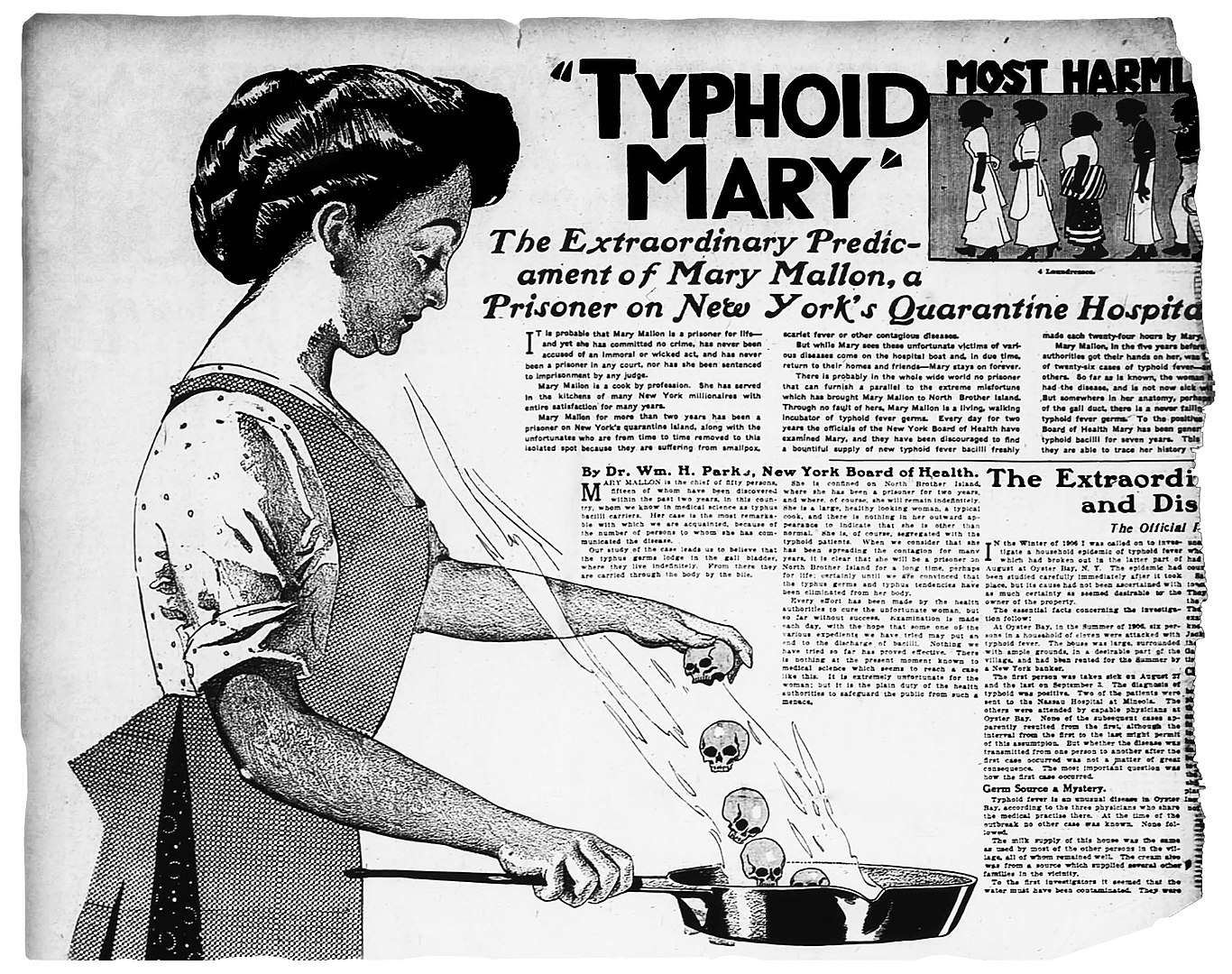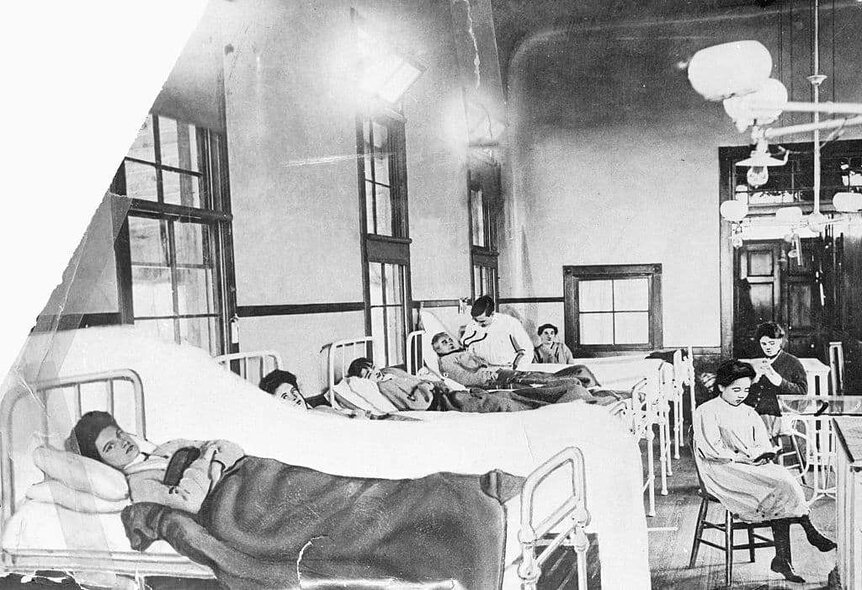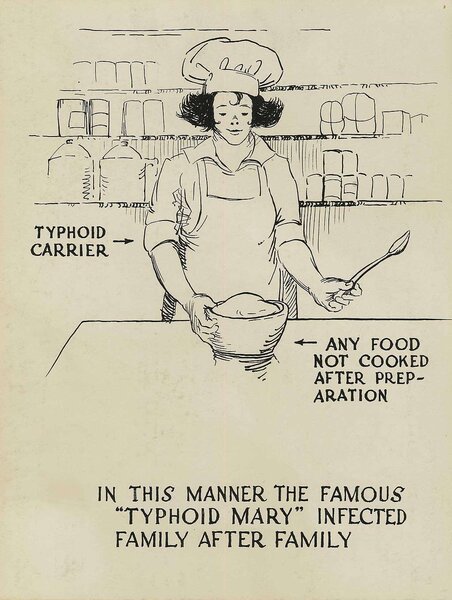The tragic tale of Typhoid Mary

Since December 2019, the COVID-19 outbreak has been responsible for more than 38.1 million reported infections, and over 1.08 million attributed deaths as of the writing of this piece. This condition and its rapid spread have brought the world to a standstill, and as the death toll rises with no hope of a vaccine in sight, public paranoia is, understandably so, at an all-time high. Nobody is safe and given that the virus can spread from people who show no symptoms of COVID, our fears of infection are ceaseless. Historically speaking, our culture is obsessed with the notion of pinning the blame for such dangers on a named individual. It happened with the mythic and oft-refuted case of Patient Zero during the outbreak of AIDS, for instance. It is easier to point to one person and cry foul than to understand the systemic failures and sheer biological luck at play when it comes to a pandemic. Such was the case for Mary Mallon, an Irish-born immigrant to America who became known by the name of Typhoid Mary.
Typhoid fever is a bacterial infection due to a specific type of salmonella that most commonly causes symptoms of fever, skin rash, vomiting, abdominal pain, and constipation. The disease remains relatively common today, mostly in countries like India and East Asia. Each year in the United States, about 400 cases are reported. Without treatment, which typically involves antibiotics, the risk of death is around one in five cases. During periods in history where easy access to sanitation is unavailable, typhoid fever proved particularly deathly. During the American Civil War, more soldiers died of typhoid fever or dysentery than battle wounds. By the early 20th century, typhoid fever was still a high risk, mostly from contaminated food or water as well as a lack of sanitary conditions.
An early form of the New York City Department of Sanitation was founded in 1881, but at the time, the streets were notoriously filthy. Mud, ash, horse manure, and general trash littered the streets. It was dishearteningly common for dead animals to lie on the roads for weeks on end, with poorer families unable to pay the cost to have their workhorses moved or buried. Residents could expect to be knee-high in this filth. Some women were forced to scavenge through the chaos to support their families, either through selling what they found or eating it. It took until the 1890s for the political powers that be to implement some form of street cleaning crew, a group of men who became known as the "White Wings" because of their uniforms. Many privileged women also made public hygiene and street cleanliness their chosen cause. This was the world that Mary Mallon lived in, and it's where her story takes shape.
Mary Mallon was born in 1869 in Cookstown, County Tyrone, in what is now Northern Ireland. She emigrated to the United States at the age of 15, a common choice for women like her in the late-1800s. After living with her aunt and uncle for a time, she eventually settled into her career as a cook for wealthier families. Over the course of seven years, Mallon worked as a cook for eight affluent families in the New York City area. This was a good job for someone in her position as it would have paid far more than, say, being a maid or laundry worker. Mallon never showed any signs or symptoms of illness, but over the years of her employment, seven families she worked for contracted typhoid fever. A deadly pattern formed. Mallon would move into a new household, and within a few weeks of her arrival, people would be seriously ill with typhoid fever.
In 1904, she was hired by Henry Gilsey, a lawyer, to work in his household. Within a week, the laundress was infected, and four other servants fell ill. Gilsey's family were uninfected, probably because the servants' quarters were separate from that of the wealthy residents. Initially, an investigator blamed the laundress for the outbreak, but he could not confirm it. By that point in time, Mallon had moved on to a new house, where further infections began. In 1906, Mallon accompanied her new employers, the Warren family, to Oyster Bay, Long Island, for the summer. While there, six of the 11 residents were infected with typhoid, which caused a minor panic in the town. Infections were rare there, and the case of the Warren family immediately struck investigators as unusual. Still, it took another year for the New York City Health Department to focus on Mallon as the source of the spread. George Soper, a sanitation engineer, was hired to uncover the outbreak at Oyster Bay. Because typhoid was known to spread through dirty conditions, it seemed particularly curious that homes of the wealthy, ones who often possessed indoor plumbing and a staff of maids to clean, were so heavily infected. Soper then put two and two together, realizing that an Irish cook had been employed at the homes of all these recent outbreaks.
When he met Mallon, who was working in a new kitchen at the time, he accused her of spreading the disease and asked for urine and stool samples to prove his hypothesis. Mallon was furious and refused. After all, she wasn't ill and had no symptoms of typhoid, so why should she get involved with this stranger who said she was responsible for the deaths of several people? At the time, the concept of an asymptomatic carrier was not well-known, even among medical professionals. Soper notified the New York City Health Department of Mallon, and she was arrested as a public health threat. In the hospital, she was forced to give stool samples and was forbidden from using the toilet on her own. After her feces tested positive for Salmonella typhi, she was sent to North Brother Island and forced to quarantine.
Mallon refused to believe that she was ill. She still showed no symptoms and felt anger at having been forcibly imprisoned despite not having committed a crime. She was also forced to give regular samples of her urine and stools but was refused care for her paralyzed eyelid. She told her lawyer that she hated being treated like a "guinea pig," and she tried to sue the New York Health Department, but her complaint was denied, and the case closed by the New York Supreme Court. Mallon was freed from quarantine in 1910 and said that she was prepared to change her occupation to prevent further spread of typhoid. While she found work as a laundress, it paid significantly less than work as a cook and she was constantly on the verge of poverty. Eventually, she returned to work as a cook, using fake surnames such as Brown and Breshof. By that point in time, Mary Mallon was infamous, known to New Yorkers as the deathly Typhoid Mary. Newspapers warned of her deadly reign and medical journals used her as a cautionary tale.
By 1915, Mallon had found work in a hospital, and a new spate of infections led Soper to rediscover Mallon's whereabouts. She fled but eventually the police found her, and she was forced back to North Brother Island. She remained there for 23 years. She died in 1938, not of typhoid but from pneumonia, having suffered a stroke seven years prior. She was 69 years old. No autopsy was performed, although rumors persisted for years that one had happened and that it had revealed evidence of live typhoid bacteria in Mallon's gallbladder.
To this day, the case of Typhoid Mary casts a major shadow. The ethical ramifications of Mallon's story are subject to intense debate. She became a victim not only of the law but of the press and the medical establishment that dehumanized her at every turn. Mallon is still held up as an example of a willing cook, an "unclean" fool who refused to stop her unwitting trail of disease. She has become a symbol for individual stupidity, a battering ram to scare people into action. She's also acted repeatedly as yet another helpful shield against the ineptitude and willful malice of the authorities during a time of crisis.
Political corruption prevented thorough action on street sanitization in New York City for many years. Healthcare was inaccessible to the majority of citizens, especially those of lower incomes who were most at-risk. There were few job opportunities open to working-class immigrant women without an education. Mary Mallon was a victim of circumstance and a woman whose tragic life inadvertently caused dozens, potentially hundreds, of illnesses. The public wanted someone to blame and she became the perfect scapegoat for a wider issue. By the time she died New York health officials had identified more than 400 other healthy carriers of the typhoid virus, but none of them were ever forcibly quarantined, experimented on, or smeared in the press as unclean.
The legacy of Mary Mallon is one of a distressing cautionary tale, that reminds us to this day of how individual actions will always be given more scorn than systemic failings and the establishment's political power-playing with people's lives. We wouldn't blame you if Mallon's story felt a touch too prescient right now.


















